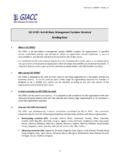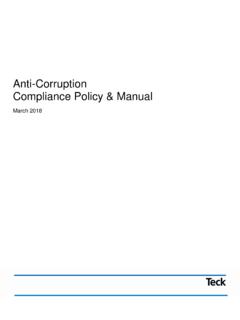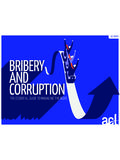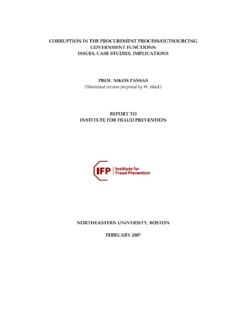Transcription of ANTI-CORRUPTION TRAINING MANUAL - GIACC - …
1 GIACCGIACCGIACCGIACC Global Infrastructure AntiGlobal Infrastructure AntiGlobal Infrastructure AntiGlobal Infrastructure anti ---- corruption CentreCorruption CentreCorruption CentreCorruption Centre TRANSPARENCY INTERNATIONAL (UK) ANTI-CORRUPTION TRAINING MANUAL (INFRASTRUCTURE, CONSTRUCTION AND ENGINEERING SECTORS) INTERNATIONAL VERSION MAY 2008 Licence to use: This MANUAL may be copied and distributed in full without consent. Extracts may be quoted without consent provided that the copyright holders are fully credited. This document may be adapted by organisations for their own use without consent provided that the adapted version contains the following statement at the beginning or end of the document Adapted from GIACC /TI(UK) s ANTI-CORRUPTION TRAINING MANUAL written by Catherine Stansbury and Neill Stansbury.
2 Disclaimer: This MANUAL is not a definitive legal text and should not be relied on as such. Independent legal advice should always be obtained. GIACC , TI(UK) and the authors accept no responsibility for the consequences of any action taken in reliance on this document. Catherine Stansbury and Neill Stansbury 2008 ANTI-CORRUPTION TRAINING MANUAL IC&E (INT) GIACC /TI(UK) May 2008 2 Contents Pages SECTION 1: General ANTI-CORRUPTION TRAINING .. 4 The use of this MANUAL .. 4 The purpose of ANTI-CORRUPTION TRAINING .. 4 What is corruption ? .. 5 Bribery .. 5 Extortion .. 7 Fraud .. 7 Collusion .. 8 Money-laundering .. 8 Relationship between bribery and fraud .. 8 Voluntary or coerced corruption ? .. 8 Other related offences .. 9 Who may be liable for corruption offences?
3 9 Individual liability .. 9 Corporate liability .. 10 Range of persons who may be liable .. 11 Overseas bribery .. 11 Why should corruption be avoided? .. 11 Risk of criminal prosecution .. 12 Risk of financial loss .. 12 The moral argument .. 13 How individuals may avoid liability for corruption .. 15 SECTION 2: Examples of corruption .. 16 Introduction .. 16 Examples Pre-qualification and tender 1. Loser s fee .. 17 2. Price fixing .. 17 3. Manipulation of pre-qualification .. 17 4. Bribery to obtain main contract award .. 17 5. Bribery during sub-contract procurement .. 18 6. Corruptly negotiated contract .. 18 7. Manipulation of design .. 18 8. Specification of overly sophisticated design .. 18 9. Inflation of resources and time requirements .. 19 10. Obtaining a quotation only for price 19 11.
4 Concealment of financial status .. 19 12. Intention to withhold payment .. 19 13. Submission of false quotation .. 20 14. Falsely obtaining export credit insurance .. 20 Project execution 15. False invoicing: supply of inferior materials .. 20 16. False invoicing: supply of less equipment .. 20 17. False work certificates .. 21 18. Excessive repair work .. 21 ANTI-CORRUPTION TRAINING MANUAL IC&E (INT) GIACC /TI(UK) May 2008 3 19. Overstating man-day requirements .. 21 20. Inflated claim for variation (1) .. 21 21. Inflated claim for variation (2) .. 22 22. False variation claim .. 22 23. Issue of false delay certificate .. 22 24. False extension of time application .. 22 25. False assurance that payment will be made .. 23 26. Delayed issue of payment certificates .. 23 27. Concealing defects (1).
5 23 28. Concealing defects (2) .. 23 29. Set-off of false rectification costs .. 23 30. Refusal to issue final certificate .. 24 31. Requirement to accept lower payment than is due .. 24 32. Extortion by client s representative .. 24 33. Facilitation payment .. 24 34. Overstating of profits .. 24 35. False job application .. 25 Dispute resolution 36. Submission of incorrect contract claims .. 25 37. Concealment of documents .. 25 38. Submission of false supporting documents .. 26 39. Supply of false witness evidence .. 26 40. Supply of false expert evidence .. 26 41. Bribery of witness .. 27 42. Blackmail of witness .. 27 43. False information as to financial status .. 27 44. False statement as to settlement sum .. 27 45. Over-manning by law firm .. 27 46. Excessive billing by lawyer.
6 28 47. Complicity by lawyer .. 28 SECTION 3: ANTI-CORRUPTION rules for 29 SECTION 4: What to do when confronted with corruption .. 30 Table 1: Corrupt situations - Preparatory steps .. 31 Table 2: Corrupt situations - Possible actions by individuals .. 32 Table 3: Corrupt situations - Possible actions by companies .. 37 ANTI-CORRUPTION TRAINING MANUAL IC&E (INT) GIACC /TI(UK) May 2008 4 SECTION 1 GENERAL ANTI-CORRUPTION TRAINING The use of this MANUAL This ANTI-CORRUPTION TRAINING MANUAL aims to help users achieve a better understanding of corruption and how to avoid it. It can be used by individuals, and also by companies as part of their corporate TRAINING . (1) Section 1 provides an overview of what constitutes corruption , who may be liable for corruption , and how it may be avoided.
7 (2) Section 2 provides 47 detailed examples of corruption throughout the project cycle. (3) Section 3 provides some simple ANTI-CORRUPTION rules which individuals should follow (and which companies could impose on their employees) to try to ensure that no corruption offence is committed. (4) Section 4 provides practical advice as to what individuals and companies should do when faced with a potentially corrupt situation. This MANUAL can be used by companies and individuals wherever they are located or working, as the general principles and examples would have worldwide applicability. However, specific legal advice should be taken in the relevant jurisdiction so as to ascertain the exact position. The purpose of ANTI-CORRUPTION TRAINING corruption is widespread in the infrastructure, construction and engineering sectors.
8 It may take place in both developed and developing countries. It may take place at any phase of a public or private sector project, and may be committed by any of the many corporate or individual participants in a project. Some corruption offences are committed knowingly and deliberately for personal or corporate gain. Some offences are committed reluctantly in the belief that it is necessary to undertake these practices in order to remain competitive, or in order to retaliate against the corrupt practices of others. Some offences are committed in the erroneous belief that these practices are normal business acts and do not constitute criminal offences. Many individuals in the infrastructure, construction and engineering sectors fail to recognise corrupt situations or, if they do recognise them, fail to appreciate the risks of becoming involved in corruption .
9 It is important to stress that whatever the apparent commercial or other justification for activities involving corruption , they nevertheless constitute criminal offences for which a number of persons may be liable including the individual employee who committed the act, his employer, and company directors. The consequences of an individual or company being involved in corruption , whether directly or indirectly, are potentially extremely serious. An individual may face imprisonment. A company may face damage to reputation, financial loss and/or debarment. There is also now far greater pressure for corruption to be detected and prosecuted. Consequently, unlike in past years, there is now a far greater likelihood that wrongdoing will be punished. The damage caused by corruption in terms of loss and injury, particularly in the developing world, is also becoming more widely understood, with the resultant realisation that all efforts must be made to eliminate corruption .
10 It is essential, therefore, that individuals and companies in the infrastructure, construction and engineering sectors acquire a better understanding of: (1) how corruption occurs on a project; (2) the personal and corporate risks of criminal and civil liability of involvement in corruption ; (3) the damage caused by corruption ; (4) what to do when confronted with corruption . ANTI-CORRUPTION TRAINING MANUAL IC&E (INT) GIACC /TI(UK) May 2008 5 What is corruption ? There is no international legal definition of corruption . For the purposes of this MANUAL , corruption includes bribery, extortion, fraud, deception, collusion and money-laundering. These will normally constitute criminal offences in most jurisdictions although the precise definition of the offence may differ.







